These articles take us back to a moment in sports history
as reported in a newspaper the next day.
Sunday, July 12, 1914, The Boston Herald, reported on the debut at Fenway Park of a 19-year-old prospect.
Red Sox Southpaw, Secured from Baltimore, Shows Up Well Against Cleveland - Leonard Holds Naps Safe in Closing Innings, Sox Winning Opener of Series by 4 to 3
Big Babe Ruth, the new southpaw pitcher of the Red Sox, made his debut as a major leaguer at Fenway Park yesterday afternoon against the Cleveland Naps and, although this latest addition to the Carrigan twirling staff didn't stay through to the finish, he will be officially credited with the winning of the game, the final score of which was Boston 4, Cleveland 3.
Ruth, along with Pitcher Shore and Catcher Ben Egan, who also figured in President Lannin's $27,500 cash deal with the Baltimore club, arrived in town only yesterday morning, but the Boston club is so hard pressed for pitchers at the present stage of the championship fight, that Manager Carrigan concluded he would let the young man have an immediate opportunity to display his wares. He made a very favorable impression upon the 11,087 fans who had clicked their way through the big turnstiles and got the warmest sort of a reception when he stepped into the box in the opening inning.
Ruth Looked Like Veteran
True it is that Ruth didn't last out the game, disappearing via the pinch-hitter route rather than for any more serious reason. It was a pretty tough position in which to place any youngster, certainly one whose experience has been as limited as the Babe's, facing hitters of the Nap Lajoie and Joe Jackson stripe. Yet Ruth didn't falter and fall, he was self-composed, never passing a man to first, showing excellent judgment in his throwing of the ball to the bases and acquitting himself all around as a veteran league boxman rather than the veriest tyro in big league company. The first big game for any recruit is alwys his toughest.
Leonard's Pitching Perfect
Ruth's departure from the scene of hostilities occurred with the conclusion of the first half of the seventh inning after the Naps in their half had tied up the score on a couple of safe hits, a sacrifice and another safe bingle, all of them into left field territory. Quite as much in the hopes of starting a little something, as because of any dissatisfaction with the Babe's performance, Manager Carrigan sent Duffy Lewis in to bat for Ruth. Duffy scratched out a hit, which, with an error and another hit, was eventually worked up into the winning run.
So it was that Boston was in the lead, 4 to 3, when Dutch Leonard took up the pitching burden for the home folks. And Leonard, it should be remarked, pitched perfect ball during the two innings he faced the tail-enders, striking out four of the six men, with noboby reaching first base.
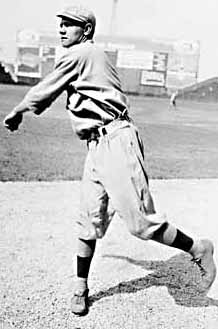
Babe Ruth 1914
New York Times article 10/2/1932 on the Third Game of the World Series in Wrigley Field, won by the Yankees 7-5 to take a commanding 3-0 lead on their way to sweeping the Cubs.
| Yankees Beat Cubs For 3d in Row, 7-5, as 51,000 Look On Ruth and Gehrig, Each with 2 Homers, Set Pace as New York Nears Series Title Babe's First Tallies 3 His Second Brings Wild Acclaim - Hartnett and Cuyler Also Deliver Circuit Drives. by John Drebinger |
|
|
CHICAGO, Oct. 1. - Four home runs, two by the master hitter of them all, Babe Ruth, and the other pair by his almost equally proficient colleague, Columbia Lou Gehrig, advanced the New York Yankees to within one game of their third World's Series sweep today. ... Those four blows made the final score 7 to 5. They crushed not only the National League standard-bearers, but a gathering of 51,000 which jammed Wrigley Field to the limits of its capacity and packed two wooden temporary bleachers outside the park. Included in the gathering was Governor Roosevelt of New York, the Democratic Presidential Candidate. It was by far the most turbulent and bitterly fought engagement of the series thus far. The Cubs, inspired by a show of civic enthusiasm, battled fiercely and courageously. ... Both the game and all its trimmings provided a much livelier spectacle than either of the two previous encounters. In sharp contrast to the rather matter-of-fact manner in which New York had accepted the first two battles, the crowd today was as keyed as the players, if not more so. It was a warm day, clear and sunny, though rather windy. There was a gay, holiday spirit in the air that never forsook the gathering, for Chicago puts a great deal more fervor in its baseball than does New York. ... Ruth's Drive Awes Throng. They roared their approval of every good play made by the Cubs. They playfully tossed bright yellow lemons at Babe Ruth and booed him thorougly as the great man carried on a pantomime act while standing at the plate. Then they sank back, awed and spellbound, as the Babe, casting aside his buffoonery, smashed one of the longest home runs ever seen at Wrigley Field. It was an amazing demonstration by baseball's outstanding figures, who a few weeks ago was ill and confined to his bed. ... Ruth and Gehrig simply dominated the scene from start to finish, and they began their performance early. When the two marched to the plate during the batting rehearsal they at once thrilled the crowd by uncorking a series of tremendous drives into the temporary wooden bleachers. Almost Clears Bleachers The Babe's very first practice shot almost cleared the top of the wooden structure, and he followed it with several more prodigious drives. Gehrig produced some more, and each time the ball soared into those densely packed stands the crowd gasped. The spectacle certainly could not have been very heartening to the Cubs. ... There was a sharp wind blowing across the playing field toward the right-field bleachers that threatened to raise havoc with the players, and it did very shortly. ... |
Cheers and jeers mingled as the great Yankee batter [Ruth] made his first official appearance at the plate ...
[Charlie] Root pitched cautiously, fearful of what would happen if he allowed the Babe to shoot one high in the air with that brisk breeze behind it. His first two offerings went wide of the plate. Then he put one over, and away the ball went. It was a lofty shot that soared on and on until it dropped deep in the temporary stands. ... That left the Cubs only one run in arrears, and in the fourth they drew even amid the most violent vocal demonstration of the afternoon. [SS Billy] Jurges ... slapped a low liner to left, and the crowd howled with glee as Ruth failed in a heroic attempt to make a shoe-string catch of the ball. Jurges gained two bases on the hit. Ruth Doffs His Cap Good naturedly, the Babe doffed his cap in acknowledgement to the adverse plaudits of the fans and the play went on. ... But it seems decidedly unhealthy for any one to taunt the great man Ruth too much and very soon the crowd was to learn its lesson. A single lemon rolled out to the plate as Ruth came up in the fifth and in no mistaken motions the Babe notified the crowd that the nature of his retaliation would be a wallop right out the confines of the park. Root pitched two balls and two strikes, while Ruth signaled with his fingers each each pitch to let the spectators know exactly how the situation stood. Then the mightiest blow of all fell. It was a tremendous smash that bore straight down the center of the field in an enormous arc, came down alongside the flagpole and disappeared behind the corner formed by the scoreboard and the end of the right-field bleachers. It was Ruth's fifteenth home run in world's series competition and easily one of his most gorgeous. The crowd, suddenly unmindful of everything save that it had just witnessed an epic feat, hailed the Babe with a salvo of applause.
An accompanying article in the Times gives further tidbits about the game, including these paragraphs: Left-field bleacherites gave Ruth the sa lute accorded Hack Wilson when he went out to his position for fielding practice. Every time a fly floated out to the Babe a couple of lemons were tossed from the lofty bleachers overhead. The Babe threw them back, but when the game started the fans showed sportsmanship in withholding their fire. Babe Silences Jeering Cubs. The Babe had a good laugh at the expense of the Cubs on the bench who directed some uncomplimentary remarks at him just before he wallopped his second homer. The drive effectually silenced the bench-warmers. |
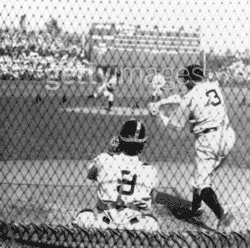 Babe Ruth taking batting practice at Wrigley Field before Game 3 of the 1932 World Series. |
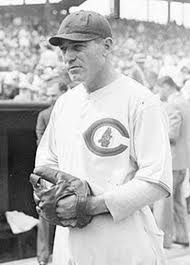 Charlie Root |
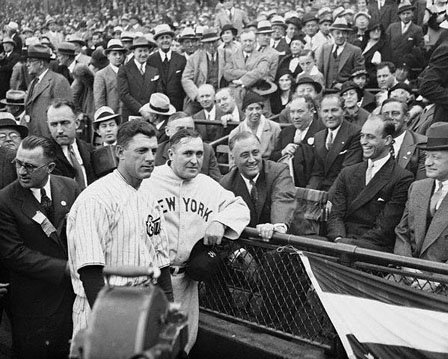
Franklin Roosevelt with managers Charlie Grimm and Joe McCarthy before
Game 3 of 1932 World Series at Wrigley Field

| FELLER'S MOTHER HIT ON HEAD BY BALL Cleveland Plain Dealer, Monday morning, May 15, 1939, page 1 by GORDON COBBLEDICK |
|
CHICAGO, May 14 - A fast ball pitched by Bob Feller and fouled from the bat of Marvin Owen, Chicago third baseman, struck and injured Mrs. William Feller, Bob's mother, as she sat among 20,000 spectators at the Indians' game with the White Sox here today. At Mercy Hospital four stitches were required to close a deep wound over her left eye where the ball struck a glancing blow as she instinctively turned her head to avoid it. Mrs. Feller was kept at the hospital over night and Bob was left behind when the Indians entrained tonight for Cleveland. He is expected to rejoin the team in Philadelphia Tuesday as physicians said his mother would be able to return to her farm home near Van Meter, Ia., tomorrow. Iowa Goes to Town Mrs. Feller came to Chicago today - Mother's Day - to join 200 Van Meter neighbors in paying honor to her 20-year-old son, strikeout king of the major leagues. She beamed proudly when Bob was called to the plate before the game to receive a portable radio, a gift from the home folks who knew him when he used to pitch on the hog lot diamond behind his father's barn. In the third inning Feller fired one of his famous fast balls at Owen. The batter swung late and fouled it off toward the first base stands, where Mrs. Feller was sitting with her husband and Bob's twelve-year-old sister, Marguerite. There was an audible gasp from the crowd. A woman had been hit. Feller, out in the middle of the diamond, grew pale. He had seen Marguerite and his father leap to their feet, had seen his mother collapse. |
The Indians had struck their heads up out of the first base dugout to survey the damage, but Manager Oscar Vitt was unaware that it was Mrs. Feller who had been injured until Hal Trosky came running in from his first base station to tell him. Vitt immediately ordered Joe Dobson to warm up in the bull pen. Then he asked the opinion of Judge Kenesaw Mountain Landis as to whether he should remove Feller from the game. Landis told him to use his own judgement and Bob stayed. Unsteady for an Inning Obviously shaken, he pitched unsteadily in that inning and the White Sox scored three runs. When he returned to the dugout after retiring the side he asked simply, "How's mother?" Vitt told him Lefty Weisman, the team's trainer, who was administering first aid in a rest room pending a doctor's arrival, had sent back word that Mrs. Feller did not seem to have been dangerously hurt. "That's swell," said Bob. Then he went out and held the Sox to two hits in the last six innings, winning the game 9 to 4. Feller's father said tonight that examination showed Mrs. Feller suffered no fracture. "Mrs. Feller saw the ball coming and threw back her head," he related, "but the ball struck her a glancing blow. She was wearing glasses and the broken glass cut her severely. The doctors say her eyeball was not cut." Continue below. |
In his 1990 autobiography Now Pitching Bob Feller, Bob told the story of his mother's injury and continued with her next appearance at one of his games.
It was a cold, damp day in Chicago, and a raw wind was blowing in off Lake Michigan. Mom, Dad and Marguerite were there. So were the Commissioner, Judge Landis, and American League president Will Harridge.
Mom had reason to keep her fingers crossed that day, and the possibility that her son would pitch a no-hitter had nothing to do with it. The family sat in that same ballpark the year before when I beat the White Sox on a six-hitter for my sixth win against only one loss by mid-May. I got them the best seats in the house, between home plate and first base.
I went the full nine innings that day, but Mom didn't. Chicago's third baseman, Marv Owen, sliced a line drive foul that shot straight in my family's direction like a guided missile on target and hit Mom in the face. She had to be helped from the ballpark and was hospitalized for two weeks with two black eyes and an ugly collection of cuts and bruises.
The whole experience was upsetting enough as it was, but one more thing made it even worse - it was Mother's Day.
So when Mom tested her luck on the following opening day, she was rewarded by seeing her son pitch a no-hitter, with no foul balls hit her way. ...
Associated Press writer Eddie Brietz wrote this article for publication June 13, 1939.
| Pageantry Marks Baseball Centennial at Cooperstown | |
|
The first hundred years are always the hardest. Old Man Baseball took off on his second century Monday after being feted at the biggest birthday party tossed him during his one hundred year rule as the No. 1 figure in American sport. There were parades, dedications, speakings, a Babe Ruth "comeback," clam bakes, ball games and whatnot for more than 11 thousand people who poured into this pretty village where Abner Doubleday sat down on a hot day and invented the national pastime. Heroes Cheer Heroes Commissioner K. M. Landis was there to lead the cheering. He received plenty of lusty rooting assists from a score of men whose names are found in every baseball bluebook. The baseball museum and hall of fame with its relics of bygone days was dedicated; so was Doubleday field, built on the spot where Doubleday's pioneers first trotted into action. Eleven living members of the hall of fame renewed feuds and friendships. Baeball as it was displayed in 1839, in the 1850s, and in 1939 - was reeled off by teams of schoolboys, soldiers and picked major leaguers, wearing uniforms of the periods they represented. Men who helped make baseball history - Babe Ruth, Connie Mack, Hans Wagner, old Nap Lajoie and Walter Johnson - sat on the platform as Landis dedicated the hall of fame "to all America." |
Hall of Fame Ten of the 11 living members of the hall of fame were presented with engraved bats. A ruffle of drums and taps were sounded for 14 deceased members. Ty Cobb was delayed en route by illness and didn't arrive until late. But the other 10 were there from Connie Mack, the 76-year-old dean, down to Babe Ruth, the freshman of the lot. Honus Wagner, greatest shortstop of them all and still active as coach of the Pittsburgh Pirates; Tris Speaker, the old "Gray Eagle" of Cleveland; Walter Johnson, the "Big Train" of Washington; Nap Lajoie, a great Cleveland star of the old days; George Sisler, holder of the world's record for safe hits in a single season; Cy Young, who won 511 major league games; Grover Cleveland Alexander, the shutout artist of his day, and Eddie Collins, former great second-sacker for the Athletics and Chicago White Sox. Wagners Win, 4-2 Ruth, Johnson, and Alexander got the largest ovations. A sellout crowd of more than 10 thousand saw a team of National and American league players, selected by Hans Wagner, defeat a team captained by Eddie Collins, 4-2, in seven innings. Mighty Ruth Pops The high spot was a "comeback" by Ruth, who lumbered out as a pinch hitter for the Wagners. The Babe popped weakly to Catcher Art Jorgens after missing one strike by a country mile and fouling off another. |
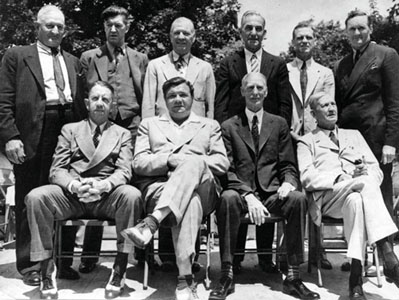
Living members of HOF at dedication; how many can you name?

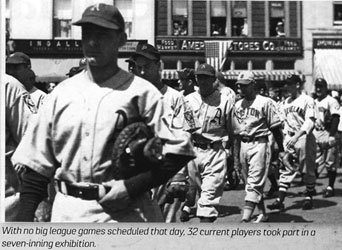
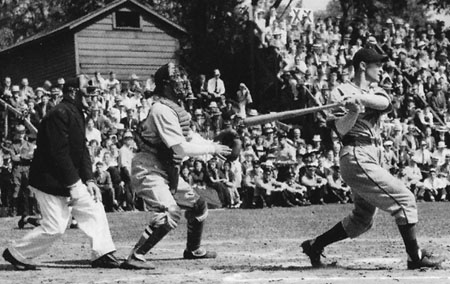
Future Hall of Famer Paul Waner hits in Wagners-Collinses Exhibition Game
|
RAY MACK'S LUNGING PLAY ENDS CLASSIC
Indians' Star Uses Only Fast Ball After 2d to Trim Sox in Opener by Gordon Cobbledick CHICAGO, April 16 - The thing that had to happen sometime happened here this chilly afternoon. |
and he swung - hard. He met it squarely and drove it humming toward right field. It was a couple of steps to Mack's left, but Ray reached it with his gloved hand and then pursued the ball onto the outfield grass. He retrieved it, whirled and shot a perfect throw to Hal Trosky that nailed Wright by a half step and the ball game was over.
Feller's teammates, gripping his hand, pounding his back, escorted him through a milling mob of fans to the runway leading to the clubhouse, and there the Indians celebrated while the flashlight bulbs flared. It was the first no-hit game in the major leagues since Monte Pearson pitched one against the Indians Aug. 27, 1938. And it was the first achieved by a Cleveland pitcher since Wes Ferrell was credited with a no-hitter against the St. Louis Browns on April 29, 1931. It was pitched in the face of difficulties. Not only was the cold, windy day unfavorable for a pitcher, but Bob was unable to throw a curve because he couldn't grip a slippery ball. After the second inning he attempted no curves at all, but had to be content with rifling his fast ball past the batters. ... He was wild at the outset of the game, while he was still trying to throw curves. Joe Kuhel, leading off in the third, drew Bob's fourth base on balls. But then he abandoned his curve entirely and his fast one was good enough to subdue the next 20 batters in order. ... Feller Says He Wasn't Sure of No-Hitter Until Last Out INDIANS REFUSE TO DISCUSS NO-HITTER |
  L: Feller pitching no-hitter 4/17/1940; R: Cartoon on sports page of Plain Dealer the next day |
|
In his 1990 autobiography Now Pitching Bob Feller, Bob included this paragraph.
Here's a trivia question that pops up on quiz shows and sports talk shows every now and then:
Q. Name the only time that every player on a team had the same batting average before a particular game and had the same average after the game.
A. April 16, 1940, when the Chicago White Sox lost a no-hit game on the opening day of the season. Every Chicago player had a batting average of .000 before and after the game. ...
|
DIMAGGIO STOPPED, BUT YANKEES WIN 67,468 SET RECORD FOR NIGHT GAME Joe's Batting Streak Ends at 56; Tribe Loses, 4-3, Trails by 7 BY GORDON COBBLEDICK
The greatest crowd in the history of night baseball - 67,468 fans - saw the Indians virtually eliminated from the pennant race in a bitter battle with the Yankees at the stadium last night. ... It was hard to say whether the huge throng that filled all but a few remote corners of the stadium was more interested in the outcome of the game or in the fact that Joe DiMaggio's record-shattering hitting streak was ended after 56 games. The great Yankee slugger failed to get the ball out of the infield in three official times at bat against Al Smith and Jim Bagby, although on each attempt he hit it more solidly than he has on many of the occasions when he has drive it into safe territory. Double Play Stops Joe Ken Keltner made a great back-handed stop behind third base to rob him in the first ining. In the fourth he walked after fouling off a three-and-two pitch. In the seventh he hit sharply to Keltner again, and was thrown out. And in the eighth, with Bagby in the box and the bases full, he grounded into a double play. That ball, a sizzler to Lou Boudreau, nearly continued DiMag's streak, for it took a bad hop just as Lou set himself to field it. But the Cleveland shortstop handled it cleanly and a record that far exceeds anything of the kind in all baseball history had come to an end. DiMaggio started his streak on May 15, after Mel Harder had held him hitless the previous day. Thus the last two times he has failed to get at least one hit in a game have been against Cleveland pitchers. In the 56 games in which he hit safely he went to bat 223 times, made 91 hits for a total of 160 bases. Among them were 16 doubles, four triples and 15 home runs. He scored 56 runs and batted in the same number. His batting average for the period of his epochal performance was .408. ,,, For years fans will recall and recount this game ... But the thing none ever will forget is how DiMaggio was stopped at Cleveland Stadium. Only a psychoanalyst could tell whether more spectators wanted DiMaggio to continue his streak or wanted it ended. |
Keltner 'Rough on Me,' Says DiMaggio as Ken Stops Batting Streak THIRD BASEMAN IS NEMESIS FOR JOE Yankee Star Recalls He Almost Halted Him Before With Same Fancy Back-Handed Stop By Eugene J. Whitney
Jolting Joe DiMaggio walked jauntily off the field at the stadium last night, trotted up the runway leading to the visitors' club house, tossed his glove into a locker and started to remove the shirt of his baseball uniform.
The Yankee dressing room was unusually quiet and the buzz of thousands of excited voices discussing the dramatic end of DiMaggio's sensational 56-game consecutive batting streak and the Indians' futile ninth inning rally, was plainly audible. It appeared that the Bombers were delaying a victory celebration out of deference to their illustrious teammate. Not one of the Yankees said, "Tough luck, Joe." They just eyed the great slugger and waited for him to make the first move. "Well, that's over," DiMaggio finally said. Teammates then let themselves go in a big way. Gloves and towels were tossed about and several of the Bombers expressed regrets that DiMaggio hadn't added another game to his history-making hitting streak. "I'm not happy that I failed to get a hit," he said. "I guess relieved would be a better word. Although I haven't been under much strain since I broke the record, there always was a little pressure until I got a hit. "That Al Smith pitched a good game, but he didn't break my streak. And neither did Jim Bagby. The guy who turned the trick was that Ken Keltner. He was a little tough on me." Ken Almost Did It Before The Yankee star then disclosed that Keltner had almost stopped his streak on the tribe's last visit to New York and before he had eclipsed the records established by George Sisler and Willie Keeler. "Keltner made the same kind of a back-handed stab in that game," DiMaggio said, "but I got a hit later." Although baseball experts are unanimous in the belief that the Yankee Clipper's consecutive hitting record won't be surpassed for many years, if ever, DiMaggio believes it might be done. "You have to have plenty of luck to run up a long streak," he said. "I had a lot of it and perhaps some other player will get the breaks later." |
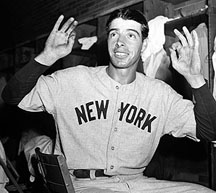
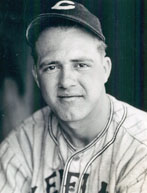 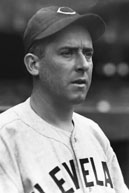 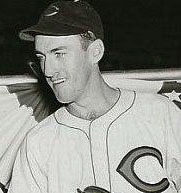 L-R: Joe DiMaggio, Ken Keltner, Al Smith, Jim Bagby Jr. |
The Boston Herald, Monday, July 15, 1946, reported on the doubleheader at Fenway Park the previous day between the Boston Red Sox and the Cleveland Indians, who were led by player-manager SS Lou Boudreau. Ted Williams went 4-for-5 with three HRs in the opener.
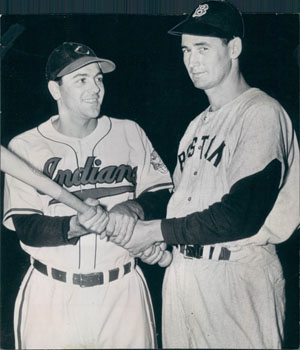
Lou Boudreau and Ted Williams
Biggest shutout ever ...
|
CHICAGO (AP) September 16, 1975 - "You've got to be a good hitter to get seven hits in one game but you've got to be lucky too," said Pittsburgh second baseman Rennie Stennett who belted four singles, two doubles and a triple in a major league record feat Tuesday in Wrigley Field. And Stennett also tied another major league record when he became only the fourth player in history to collect two hits in one inning twice in one game. Stennett and the Pirates were involved in other marks in the 22-0 rout of the Chicago Cubs. It was the largest shutout margin in major league history and the highest run total in the majors this year. Stennett, 24, laughed in reply to one dressing room question: "Man, of course it's the first time I ever got seven hits in a game." The slender native of Panama said he had five hits in a game in the minor leagues but four hits in a single game was his best since he joined the Pirates in 1971. "I've always enjoyed hitting in Wrigley Field," he added. Then he recalled, "My last time here (July 4) I got hit in the head and didn't play." Manager Danny Murtaugh almost didn't let Stennett have his shot at the record. "I thought the record was six hits in a game and I kept wanting to take him out to rest him but he kept getting hits." Stennett's record hit, tying the pre-modern mark set in 1892 by Wilbert Robinson of the Baltimore Orioles, was a sinking liner to right that skipped away from the Cub outfielder. |
"I thought that last one might get caught," Stennett said. "I hit it real good but I was afraid it was starting to float."
After tripling in the eighth, he was lifted for a pinch runner. The Pirates collected 24 hits and every player in the starting lineup had at least one hit and scored at least one run. Their 22 runs was the highest in the majors this season and the most in the National League since Sept. 2, 1957, when the Milwaukee Braves routed the Cubs 23-10. Dave Parker hit his 24th home run and Richie Hebner smashed his 15th in the Pirates onslaught which included sending 14 men to the plate in a nine-run first inning and 11 men to the plate in a six-run fifth inning. John Candelaria, 8-5, cushioned by the barrage against Cubs starter and loser Rick Reuschel, 10-16, spaced three hits before he was lifted after the seventh inning. Only three players in history equaled Stennett's feat of twice getting two hits in a single inning - Max Carey of Pittsburgh in 1925, and two American Leagues, John Hodapp of Cleveland in 1928 and Sherman Lollar of Chicago in 1955. The Pirates' 22-0 triumph surpassed the record of 21-0 set in 1901 by Detroit against Cleveland and matched in 1939 by the New York Yankees against the Philadelphia Athletics. The victory also strengthened the Pirates' hold on first place in the National League East and moved them closer to their fifth title in the last six years. |
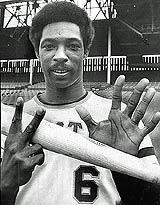 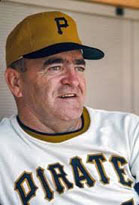 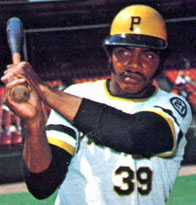 L-R: Rennie Stennett, Danny Murtaugh, Dave Parker |
|
|
OMAHA, Neb. - Pitching, defense and hothitting Jeff Yurtin kept LSU alive in the 40th annual College World Series Sunday afternoon. The No. 2-ranked Tigers, paced by Yurtin's four-hit, five-RBI performance, eliminated No. 7 Maine, 8-4, before an estimated 9,000 fans at Rosenblatt Stadium. ... "They weren't knocking the cover off the ball outside of Yurtin," Maine coach John Winkin said. "Let's face it: The ball had eyes for them today, they capitalized on their running and they made the double play. That's the difference, but that's also the mark of a good team." Yurtin, a senior third baseman, collected four of LSU's eight hits to raise his average from .354 to .366. He ripped a solo home run in the seventh, a two-run double in the first and a two-run single in the third. He also started one of LSU's four double plays and snared a line drive off Don Hutchinson's bat to end a Maine rally in the fourth inning. "This is the first day that I've actually put together a complete game," Yurtin said. "I'm just happy that we won because we needed to win to stay here." Yurtin wasn't the only LSU hero in the field. Left fielder Rob Hartwig robbed leadoff hitter Gary LaPierre of an extrabase hit with a diving catch in the first. And center fielder Mike Papajohn and shortstop Jeff Reboulet collaborated to gun down Maine's Mike Bordick, who tried to stretch a double into a triple in the fifth. "We had a lot of good fortune today," LSU coach Skip Bertman said. "A lot of our ground balls found holes between third and short. They weren't hit very hard. "Some of their ground balls were 'at 'em' balls, and allowed us to get four double plays and kill those innings." |
The Tigers struck quickly, scoring two runs in the top of the first, three in the third and one in the sixth for a 6-0 lead. Yurtin gave the Tigers a 2-0 lead in the first with a double to left-center field agains Maine starter Jeff Plympton, 8-3. Yurtin struck the key blow again in a three-run third inning with a two-run single. The Tigers' lead grew to 5-0 as Rob Leary stayed in a rundown long enough for Jim Bowie to score from third. The Tigers - who lost to Loyola-Marymount, 4-3, Friday night - made it 6-0 in the fourth as Craig Faulkner scored on Burke Brossard's groundout. "It's easier to pitch when your team gets two or three runs in the first inning," said LSU starter Stan Loewer, who pitched the first 5 2/3 innings. "You don't have to play with the batters or try and paint the corners. Our defense played great behind us all year and they did it again today." The Black Bears cut the deficit to 6-2 with single runs in the fourth and fifth. LSU scored an unearned run in the sixth to make it 7-2, but Maine pulled within 7-4 on Bill Reynolds' two-run homer in the bottom half of the inning. Bertman didn't hesitate to pull Loewer at this point in favor of freshman Dan Kite. But Kite didn't last long. After walking Hutchinson, Gregg Patterson came on and struck out Dave Gonyar to end the inning. Yurtin's 10th home run closed out the scoring in the seventh. Loewer, 14-4, recorded his sixth straight victory. Patterson allowed one hit over the final 3 1/3 innings to register his first save of the year. Bertman said he will start either Mark Guthrie (9-1) or Patterson (3-0) Wednesday night. |
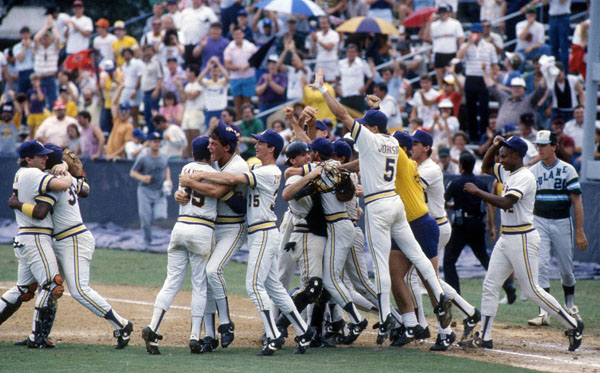 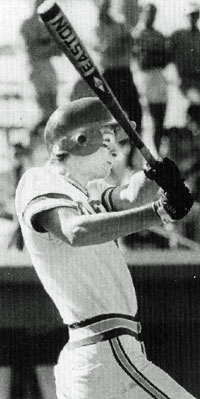 L: 1986 Tigers celebrate Regionals victory to qualify for Omaha for first time; R: Jeff Yurtin |
|
by Joe Macaluso
COLLEGE STATION, Texas - There has never been a baseball squeezed so tightly. First baseman Pete Bush had it. That Pat Garrity threw it - a long throw that had 4,200 mostly Texas A&M fans holding a collective breath - was most improbable. Check it out: Here was a reserve third baseman who: After LSU's 5-4 victory, the fourth win in 36 hours - the Tigers had been on the bubble since Friday night's 6-4 loss to South Alabama - and he was talking with reporters about driving in the game-winning run in the 11th inning against the No. 1-ranked Aggies. He talked about how the Tigers accomplished what many thought was impossible, to beat the Aggies in their own yard, Olsen Field, and to beat a team that had waltzed through its first three regional games by outscoring the opposition 65-13. "I was in shock when Coach (Skip Bertman) told me to get a bat," Garrity said. "I hadn't hit in so long. I know I just wanted to get a hit ... get a pitch and hit it." He picked a hanging curve from Scott Centala, regarded as the Aggies' best, a superstar reliever with All-Southwest Conference credentials. The two-out double high off the wall in right field drove in Craig Cala who had doubled six pitches earlier. The lead secured, Garrity went to third, where he was hanging tight on the line when he took a hot smash deep behind the bag and threw out one of the fastest players in college baseball, A&M's lead-off hitter Kirk Thompson. When the ball hit Bush's glove a half-step ahead of Thompson, the improbable was done. LSU was champion of the Central Regional. Later this week, ..., the Tigers will know who and when they will play in their third appearance in four years at the College World Series at Rosenblatt Stadium in Omaha, Neb. ... There were so many heroes wearing first home whites in the 13-5 win earlier Sunday which forced the championship game, then road grays in the game that forced a tear from every Aggie worth his salt. "Truly, this was a team victory, this regional, this trip to Omaha," Bertman said. "These last 36 hours were incredible. ... I mean you just can't underestimate the power of the mind. These kids really believed they could win. I heard things on our bench tonight - things like 'See a hit. Visualize what it would be like seeing a hit right now' for whoever it was at the plate - that I never thought I'd hear in baseball." Why Garrity? Bertman's first response was that Garrity was a better curveball hitter than Luis Garcia, whom he replaced, and Centala was an outstanding curveball pitcher. "I wanted to make the move earlier, but Luis was leading off the inning (the eighth) and I didn't," Bertman said. That was an answer. The explanation went a lot deeper. "I really believe that in situations like that good things happen to good people. Good kids come through," Bertman said. |
"Pat has been one of those kids who come out every day, never complains, always is there working as hard as a starter, taking his groundballs and his cuts in the (batting) cage. I just somehow knew that he would do it. Don't ask how, I just knew." Of course, there were other reasons, other players. Bush, for instance, came up with a clutch single over second to send home Scott Schneidewind in the eighth to tie the score at 4-all. Schneidewind, who stole second, was on to run for third baseman Phil Espinosa who had walked. There were four pitchers, all of whom were pitching on less than two days rest in the championship game. There was Curtis Leskanic, who had beaten South Alabama Saturday night when he threw 39 strikes among his 42 pitches and came back to throw 66 pitches in the championship game. There was freshman Paul Byrd, who had worked in four of the six regional games relieving starter Russ Springer in the third. Then there was Ben McDonald, the ace of the staff who had thrown 118 pitches through seven innings in Sunday's first game. That McDonald, the tournament's MVP, faced the .385 hitting Thompson was a twist of fate Leskanic hated to recall. "I thought I had struck out that last guy," said Leskanic, a junior right-hander. "I threw a good pitch on 3-2 and when I saw Mike (catcher Bianco) jump, I jumped too. "When the umpire called that pitch a ball, I just couldn't believe it. That was a good move by Coach Bertman to get me out. I was out of it." Bianco backed up his teammate. "I just think the umpire was too much into the game. ... There's no doubt that everyone, including the batter ... knew it was a strike. It was a great pitch, but the ump didn't want anyone to come out of either dugout and argue. It was a terrible call. "He had given them three runs in the first inning when Russell (Springer) struck that guy out on a 3-2 pitch with the bases loaded. He called ball four and then the next guy just reached out and chinked one into left field to give them three runs. He was a terrible ump." Sharing All-Regional honors with McDonald and Leskanic were LSU leftfielder Matt Gruver, the leading hitter in the tournament; Tookie Johnson, who drove in the game-winning run in Saturday night's win over South Alabama; and designated hitter Wes Grisham, who made up for a .214 average through the first four games with a two-run homer among his five hits in nine at bats and five RBI in Sunday's two games. Then there was Chad Ogea, who worked eight solid innings in Saturday's 13-8 victory that sent Nevada-Las Vegas packing, a win that started what arguably was the most memorable 36 hours in LSU baseball history. It started a string of 55 hits, 37 runs and a staff that held the opposition scoreless in 26 of the 36 innings. "I can't tell you how we did it," Bianco said, "but I can tell you why we were able to beat a team with a 58-6 record, a team that hadn't lost two games in a row all year. Going to the College World Series has been our goal since last September. After we won the first game against Texas A&M, we knew we'd win the second. We didn't know how or when, but we knew we'd do it." |
 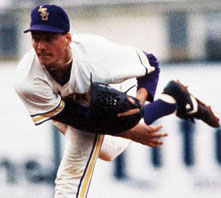 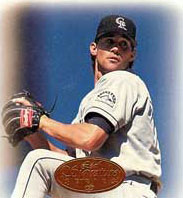 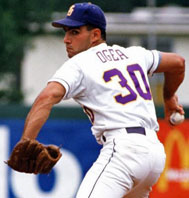 L-R: Pat Garrity, Ben McDonald, Curtis Leskanic, Chad Ogea |
|
CONTENTS
Did Ruth Call His Shot in the 1932 World Series?
Feller Hurls Opening Day No-Hitter
Tigers Stay Alive by Beating Maine